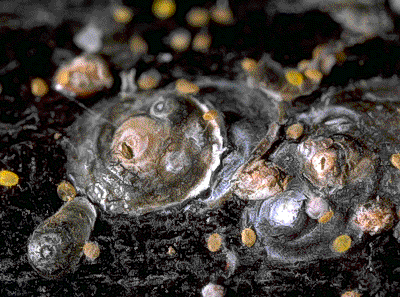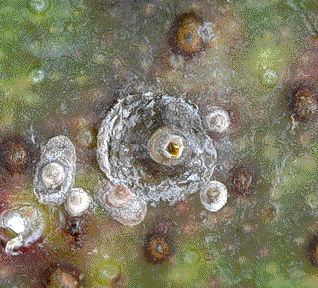San Jose Scale
 Scientific Name
Scientific Name
Quadraspidiotus perniciosus
Host
This species is known to infest over 60 species of fruit and ornamental trees and shrubs. Pyracantha and cotoneaster are especially susceptible to severe damage. In Oklahoma, it has been recorded from pecan, quince, poinsettia, rubber plant, ivy, Oregon grape, apple, trifoliate orange, plum, pyracantha, pear, and spirea. It occurs mostly on the bark but will infest fruit and occasionally leaves.
Symptoms
 Damage is caused when nymphs and adult females pierce plant tissue with their long
thread-like mouthparts and suck out plant fluids. The greenish host tissue of shoots
and leaves around the scale often turns red. On twigs and small branches the red color
extends deeply into the inner bark to the xylem, but the color is not visible at the
surface of thick bark. A high population will cause twig and branch dieback, and if
some degree of control is not exercised, the entire plant may die. All parts of the
host plant except roots may be attacked.' However, the greatest populations occur
on twigs and branches where the buildup of scale covers forms a gray crust.
Damage is caused when nymphs and adult females pierce plant tissue with their long
thread-like mouthparts and suck out plant fluids. The greenish host tissue of shoots
and leaves around the scale often turns red. On twigs and small branches the red color
extends deeply into the inner bark to the xylem, but the color is not visible at the
surface of thick bark. A high population will cause twig and branch dieback, and if
some degree of control is not exercised, the entire plant may die. All parts of the
host plant except roots may be attacked.' However, the greatest populations occur
on twigs and branches where the buildup of scale covers forms a gray crust.
Life Cycle
Partially grown male and female scales overwinter and mature in the spring. After mating, the females produce living young; unlike most scale insects which lay eggs. Feeding and development proceed rapidly, resulting in four or five overlapping generations per year.
Description
The female scale covering is gray, circular, and slightly convex with the exuviae (first molted skin) subcentral and pale or reddish yellow. The exuvia appears as a nipple-like structure surrounded by a circular depression. The male scale is similar in color to the female but is elongate-oval with the exuviae near one end.
Control
Please contact your local county extension office for current information.
